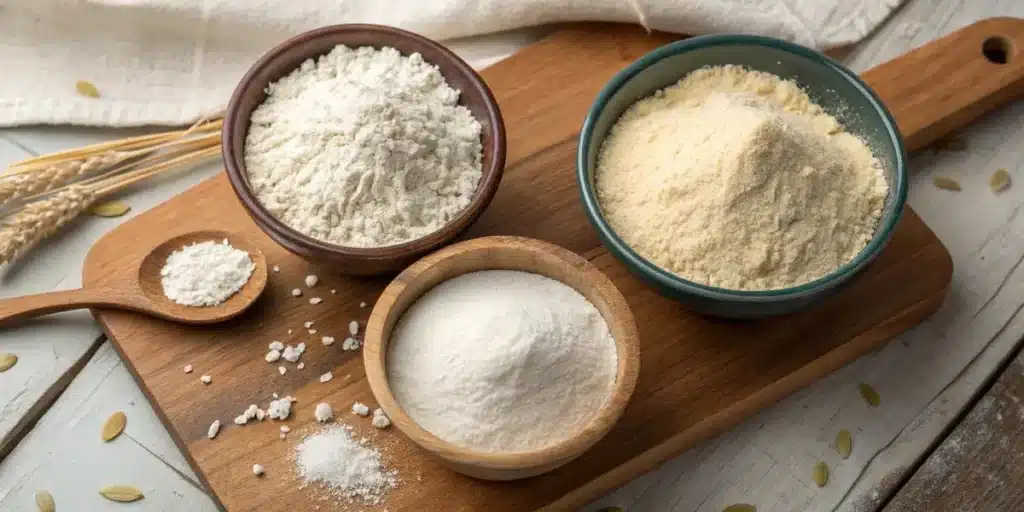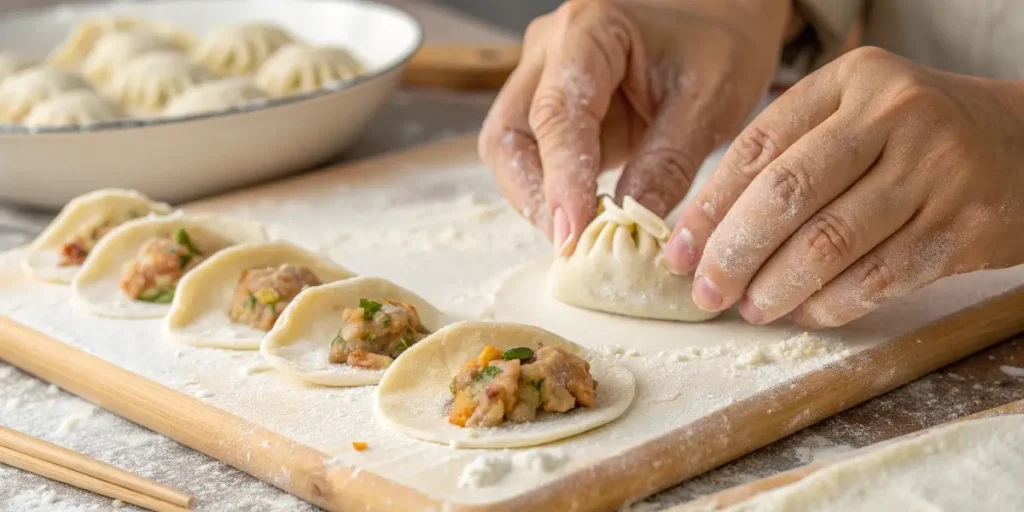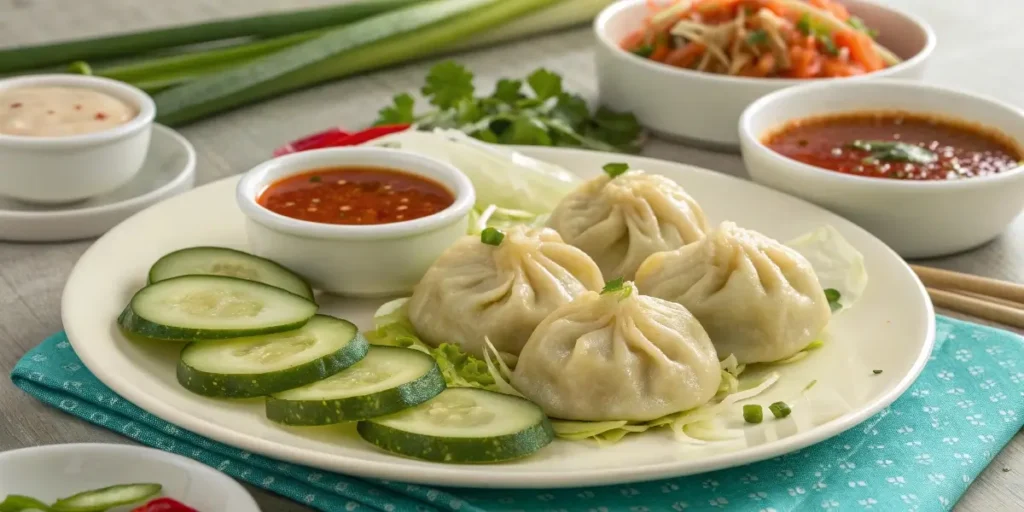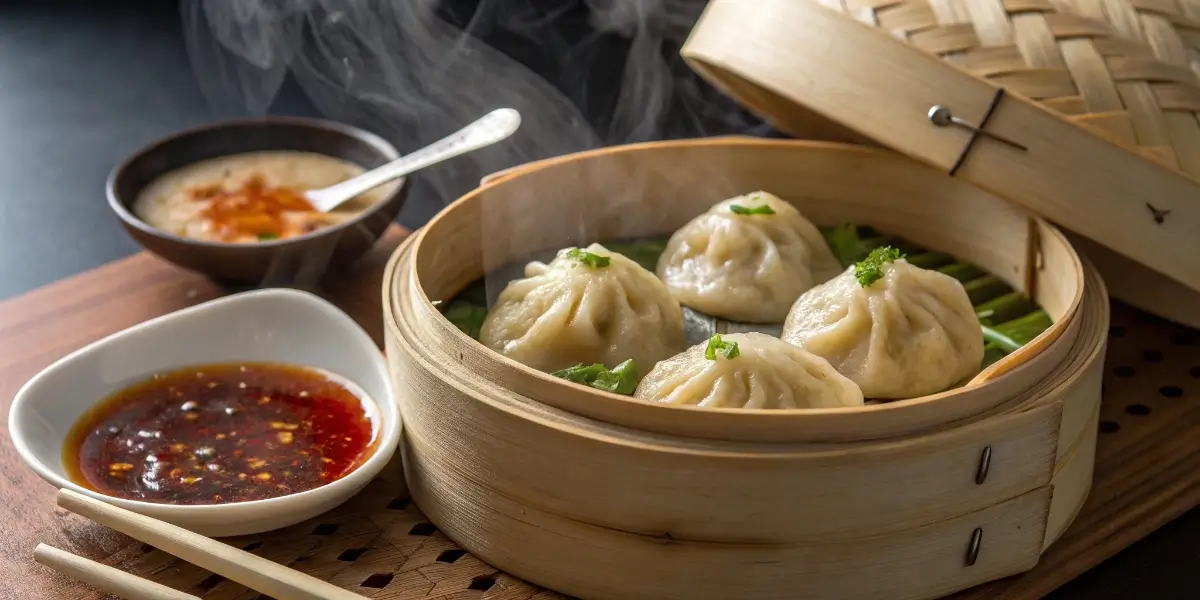Gluten Free Dumplings: The Ultimate Guide to Delicious Allergy-Friendly Comfort Food
There’s nothing quite like the comforting bite of a warm dumpling—soft, chewy, and bursting with flavor. But for those avoiding gluten, this beloved comfort food often feels off-limits. The good news? Gluten free dumplings are not only possible but incredibly delicious when made right. This guide will walk you through everything you need to know—from choosing the best gluten-free flours to mastering the art of perfect wrappers and fillings. Whether you’re craving traditional Asian-style dumplings or inventive modern versions, you’ll find practical tips, recipes, and brand recommendations here.
Learn more about Gluten-Free Side Dishes to complete your meal pairing ideas.
Table of Contents
Introduction to Gluten Free Dumplings
What Are Gluten Free Dumplings?
Gluten free dumplings are a variation of traditional dumplings made without wheat, barley, or rye. Instead, they use gluten-free flour alternatives such as rice flour, tapioca starch, or potato starch. These flours create a tender, chewy texture that mimics the original—without triggering gluten sensitivity or celiac reactions.
Typically, dumplings consist of two parts: the wrapper (or dough) and the filling. The gluten-free version follows the same structure but requires a careful blend of flours and binders like xanthan gum or psyllium husk to achieve elasticity. The goal is to retain the iconic texture while keeping the dish fully gluten-free.
What’s great about these dumplings is their versatility. They can be boiled, steamed, pan-fried, or even air-fried for a crispy finish. You can also fill them with a variety of ingredients—chicken, vegetables, tofu, or shrimp—all while maintaining a safe, gluten-free base.
Why Go Gluten-Free? Understanding the Benefits
For many, going gluten-free isn’t just a trend—it’s a health necessity. People with celiac disease or gluten sensitivity experience uncomfortable digestive symptoms and inflammation after consuming gluten. Substituting gluten-containing ingredients with gluten-free alternatives helps alleviate these issues and promotes better gut health.
Beyond medical reasons, a gluten-free lifestyle often leads to cleaner eating habits. Since gluten-free cooking relies more on whole ingredients and natural flours, you avoid heavily processed additives often found in pre-packaged wheat-based foods.
Moreover, gluten-free dumplings make it possible to enjoy cultural classics again. Asian-style potstickers, Polish pierogi, or even Southern-style drop dumplings can all be made without gluten—offering nostalgic comfort in a healthier form.
If you enjoy exploring Asian flavors, check out our Edamame Dumpling Recipe for inspiration.
Are All Dumplings Gluten-Free?
Traditional Dumplings vs. Gluten-Free Dumplings
Let’s clear up one of the most common questions: Are all dumplings gluten-free? The short answer is no—traditional dumplings usually contain gluten because they’re made with wheat-based flour. Whether you’re eating Chinese potstickers, Japanese gyoza, or European pierogi, most use all-purpose flour or wheat flour to achieve their soft, elastic texture.
In contrast, gluten free dumplings use a special blend of flours that don’t contain wheat, barley, or rye. Popular substitutes include rice flour, tapioca starch, and potato starch, which work together to recreate the stretchiness of wheat dough. To hold everything together, binders like xanthan gum or psyllium husk are often added, giving the dough enough flexibility to fold and seal properly.
Here’s a simple comparison table that highlights the key differences:
| Feature | Traditional Dumplings | Gluten-Free Dumplings |
|---|---|---|
| Main Flour | Wheat or All-Purpose Flour | Rice, Tapioca, or Potato Flour |
| Contains Gluten | Yes | No |
| Elastic Texture | Naturally from Gluten | From Binders like Xanthan Gum |
| Taste | Slightly Chewy, Wheaty | Light, Neutral, or Mildly Sweet |
| Best For | Regular Diets | Gluten-Free or Celiac Diets |
If you’ve recently transitioned to a gluten-free diet, the first step is recognizing that restaurant dumplings or frozen brands are rarely gluten-free unless specifically labeled as such. Even fillings or sauces may contain hidden gluten sources like soy sauce or wheat-based thickeners.
To safely enjoy dumplings without worry, it’s best to make them at home using trusted ingredients or choose certified gluten-free brands. You can also explore creative recipes like our Gluten-Free Fettuccine Alfredo for more gluten-free comfort food inspiration.
Common Gluten Sources Hidden in Dumplings
While wheat flour is the obvious source of gluten, many dumpling ingredients and accompaniments contain hidden gluten that might surprise you. Here are some sneaky sources to watch for:
- Soy Sauce – Most traditional soy sauces use wheat in fermentation. Always opt for tamari or certified gluten-free soy sauce alternatives.
- Fillings – Meat or veggie fillings may use breadcrumbs, wheat starch, or pre-mixed sauces containing gluten.
- Thickeners – Some commercial dumpling fillings use gluten-containing starches to bind ingredients together.
- Cross-Contamination – If dumplings are cooked in shared water or pans that previously held wheat-based foods, gluten residue can easily transfer.
To keep your dish 100% safe, always read ingredient labels carefully and cook in a dedicated gluten-free space. For added inspiration, check out Gluten-Free Soft Pretzels—a great example of how flour alternatives can perfectly mimic traditional recipes.
Best Gluten-Free Flours for Dumpling Wrappers

Top Gluten-Free Flour Options (Rice, Tapioca, Potato, Almond, etc.)
When it comes to crafting the perfect gluten free dumplings, the key lies in choosing the right combination of flours. Since gluten provides the elasticity and chewiness in traditional dough, replacing it means working strategically with gluten-free alternatives that mimic those textures. Let’s explore the top contenders:
- Rice Flour – The foundation of most gluten-free dumpling recipes. Rice flour offers a neutral flavor and soft texture, making it ideal for wrappers that are both pliable and tender.
- Tapioca Starch – This starch adds stretchiness and a slightly chewy texture, similar to what gluten provides. It’s also perfect for making translucent dumpling skins.
- Potato Starch – Potato starch helps retain moisture, preventing dumplings from becoming too dry. It’s often used in combination with rice or tapioca flour.
- Cornstarch – While not a standalone flour for dough, a small amount can help achieve a smoother texture and add structure.
- Almond Flour – Adds richness and a slightly nutty flavor. However, because it’s dense, it’s best blended with lighter flours.
- Sorghum or Buckwheat Flour – Great for earthy, hearty dumplings. These flours are more nutritious and add depth of flavor.
Below is a simple table comparing the top gluten-free flours and their main characteristics:
| Flour Type | Texture | Flavor Profile | Best Used With |
|---|---|---|---|
| Rice Flour | Soft, Light | Neutral | Tapioca or Potato Starch |
| Tapioca Starch | Chewy, Elastic | Slightly Sweet | Rice or Corn Flour |
| Potato Starch | Moist, Smooth | Neutral | Rice or Tapioca Flour |
| Almond Flour | Dense, Nutty | Mildly Nutty | Rice Flour |
| Sorghum Flour | Firm, Hearty | Earthy | Tapioca or Potato Starch |
When mixed correctly, these flours can produce a dough that’s easy to roll, fold, and pleat—just like traditional dumplings.
How to Choose the Right Blend for Texture and Taste
Finding the perfect gluten-free flour blend can feel intimidating, but it doesn’t have to be. The secret is balance. You want a blend that combines starch for elasticity, light flour for structure, and a binder for cohesion.
Here’s a sample DIY blend that works beautifully for gluten-free dumpling wrappers:
- 1 cup rice flour
- ½ cup tapioca starch
- ¼ cup potato starch
- 1 teaspoon xanthan gum (or psyllium husk as a natural alternative)
- Pinch of salt
Mix these ingredients well before adding water to form the dough. The resulting texture should be soft, pliable, and not sticky. If the dough feels dry, add a teaspoon of warm water at a time until smooth.
If you prefer convenience, consider using a pre-made gluten-free flour mix designed for baking. Just make sure it’s certified gluten-free and free from cross-contamination.
For more inspiration on combining gluten-free ingredients into hearty meals, check out our Gluten-Free King Cake—a fantastic dessert that proves gluten-free doesn’t mean flavor-free.
Pro Tips for Flour Blends
- Avoid single-flour doughs: Using only rice or almond flour often results in crumbly wrappers. Always blend flours for the best texture.
- Measure by weight, not volume: Gluten-free flours vary in density, so use a kitchen scale for consistent results.
- Rest the dough: Allowing your dough to rest for 15–20 minutes helps hydrate the starches, improving elasticity.
- Use warm water: It helps activate the starches and makes the dough easier to work with.
If you love experimenting with gluten-free cooking, discover more wholesome recipes in our Gluten-Free Brioche Bread post—it’s an excellent example of soft texture achieved without wheat.
How to Make Gluten Free Dumplings at Home
Step-by-Step Recipe for Gluten-Free Dumpling Dough
Making gluten free dumplings at home might seem like a challenge, but once you understand how the dough behaves, it becomes surprisingly simple. The secret lies in the flour blend and moisture balance. Below is a tried-and-true recipe for soft, pliable dumpling dough that won’t crack or fall apart during cooking.
Ingredients:
| Ingredient | Quantity |
|---|---|
| Rice flour | 1 cup |
| Tapioca starch | ½ cup |
| Potato starch | ¼ cup |
| Xanthan gum | 1 tsp |
| Salt | ½ tsp |
| Warm water | ¾ cup (adjust as needed) |
| Olive oil (optional) | 1 tbsp |

Instructions:
- Mix the dry ingredients
In a large bowl, combine rice flour, tapioca starch, potato starch, xanthan gum, and salt. Mix until well incorporated. - Add warm water
Slowly pour in the warm water while stirring. The heat helps activate the starches, giving your dough the stretch it needs. - Knead until smooth
Knead for 5–7 minutes until the dough forms a soft, elastic ball. If it feels too dry, add a teaspoon of water at a time. If sticky, sprinkle a bit more rice flour. - Rest the dough
Cover the dough with a damp towel and let it rest for 15–20 minutes. This step allows the flours to fully hydrate, making it easier to roll out. - Roll and shape
Divide the dough into small pieces. Roll each into a thin circle (about 3 inches wide). Use a little tapioca starch to prevent sticking. Fill with your choice of stuffing and seal tightly by pinching the edges.
This recipe yields about 20–25 gluten-free dumplings, depending on size. You can freeze them raw for later or cook them immediately using one of the methods below.
Cooking Methods: Boiled, Steamed, and Pan-Fried Variations
The beauty of dumplings is their versatility—you can prepare them in several ways depending on your preference. Each method creates a slightly different texture.
1. Boiled Dumplings
Boiling produces soft, chewy dumplings that are perfect for soups or stews. Bring a large pot of salted water to a boil, gently drop in the dumplings, and cook for 5–6 minutes or until they float. Remove them carefully to avoid tearing.
2. Steamed Dumplings
For delicate dumplings with tender skins, steaming is the best option. Place parchment paper or cabbage leaves inside a steamer basket to prevent sticking. Steam for 10–12 minutes, or until translucent and cooked through.
Tip: Use bamboo steamers for an authentic touch—they distribute heat evenly and preserve moisture.
3. Pan-Fried Dumplings (Potstickers)
If you love crispy bottoms with a chewy top, pan-frying is the way to go. Heat a tablespoon of oil in a non-stick pan, add the dumplings flat-side down, and cook until golden. Then pour in ¼ cup of water, cover immediately, and steam for 5–6 minutes. Remove the lid and let them crisp for another minute.
Don’t miss our Gluten-Free Summer Salads—they’re the perfect refreshing side dish for these dumplings.
Gluten-Free Dumpling Fillings
Savory Options: Chicken, Pork, Vegetable, and Tofu Fillings
When you’ve perfected your gluten-free dumpling dough, the next step is filling it with irresistible flavors. The beauty of gluten free dumplings lies in their versatility—you can stuff them with almost anything! From juicy meats to plant-based combinations, here are some of the best filling ideas that pair perfectly with your gluten-free wrappers.
1. Classic Chicken and Veggie Filling
A crowd-pleaser that’s juicy and light. Combine ground chicken, minced garlic, shredded cabbage, green onions, and a splash of gluten-free tamari for umami flavor. Add grated ginger for a refreshing bite. This filling works great for both pan-fried and steamed dumplings.
2. Savory Pork and Chive Filling
If you love traditional Asian dumplings, this gluten-free version captures all the flavors—without the wheat. Use ground pork, finely chopped chives, garlic, ginger, and sesame oil. To keep it gluten-free, ensure any soy or hoisin sauce used is certified gluten-free. The pork fat renders beautifully, giving your dumplings a tender, flavorful interior.
3. Vegetable Medley Filling
Perfect for vegetarians and vegans, this mix is both colorful and delicious. Combine shredded carrots, chopped mushrooms, cabbage, and tofu or edamame for protein. Sauté lightly in sesame oil, then season with garlic, tamari, and a pinch of salt. This mix is light yet hearty—a fantastic balance of flavor and texture.
4. Spicy Shrimp Filling
For seafood lovers, this variation adds a spicy twist. Use chopped shrimp, chili flakes, and cilantro for a bold, aromatic filling. Add a small amount of cornstarch to help bind the mixture together.
If you love creative Asian dishes, check out our Edamame Dumpling Recipe for another protein-rich, gluten-free option you can pair with your dumpling dough.
Creative Flavor Combinations for Every Palate
You don’t have to stop at traditional fillings—experimenting is part of the fun. Try these creative gluten-free combinations for your next dumpling night:
| Filling Type | Main Ingredients | Best Cooking Method |
|---|---|---|
| Thai-Inspired | Ground chicken, lemongrass, coconut milk | Steamed |
| Italian Fusion | Ricotta, spinach, and garlic | Boiled or Pan-Fried |
| Mexican Twist | Black beans, corn, and chili powder | Pan-Fried |
| Vegan Delight | Tofu, kale, and sesame oil | Steamed |
| Breakfast Dumplings | Eggs, bacon bits, cheese (GF) | Pan-Fried |
Each mix can be adjusted to taste—add chili oil for heat, lime juice for brightness, or miso paste (gluten-free certified) for extra depth.
Gluten-Free Dumpling Mixes and Ready-to-Use Options
Can You Buy Gluten-Free Dumpling Mixes?
Absolutely! While making gluten free dumplings from scratch offers total control and freshness, sometimes you just want convenience without compromising taste or safety. Fortunately, several brands now produce ready-to-use gluten-free dumpling mixes that make the process easier than ever. These pre-blended flours already contain the ideal ratio of rice, tapioca, and starches—so all you need to do is add water (and sometimes oil).
When shopping for dumpling mixes, look for these features on the packaging:
- Certified Gluten-Free Label – Ensures there’s no cross-contamination with wheat, rye, or barley.
- No Artificial Additives – Clean ingredient lists make for better flavor and digestion.
- Versatility – Choose a mix that can be used for both savory and sweet dumplings.
Here are some of the most reliable and high-rated brands found in the gluten-free community:
| Brand | Key Ingredients | Highlights |
|---|---|---|
| Bob’s Red Mill Gluten-Free 1-to-1 Baking Flour | Rice flour, potato starch, xanthan gum | Works perfectly for dumpling doughs and pastries. |
| King Arthur Gluten-Free Flour | Rice flour, sorghum flour, tapioca starch | Great elasticity, holds moisture well. |
| Cup4Cup Multipurpose GF Flour | Cornstarch, milk powder, xanthan gum | Produces a soft, chewy texture similar to wheat. |
| Pillsbury Gluten-Free Flour | Rice flour, potato starch, pea fiber | Light texture, mild flavor, and easy to knead. |
| Namaste Foods GF Perfect Flour Blend | Brown rice flour, tapioca starch, arrowroot powder | Certified gluten-free, allergen-friendly, non-GMO. |
If you’d like to learn how to use one of these blends creatively, check out our detailed guide on Pillsbury Gluten-Free Flour. It covers baking tips, substitutions, and how to achieve the perfect dumpling dough consistency.
Top Store-Bought Gluten-Free Dumplings and Where to Find Them
Don’t have time to make dumplings from scratch? No worries! Several brands offer frozen or refrigerated gluten-free dumplings that taste surprisingly authentic. While options may vary depending on where you live, these are some popular choices available in major grocery stores and online:
- Feel Good Foods Gluten-Free Potstickers – Available in chicken, vegetable, and pork varieties. Found in Whole Foods and major supermarkets.
- Trader Joe’s Gluten-Free Gyoza (Seasonal) – Light, flavorful, and made with rice flour wrappers.
- Lucky Foods Seoul Gluten-Free Vegetable Mandu – A Korean-style dumpling with a plant-based filling.
- Dumpling Daughter GF Line – Gourmet options available online for delivery.
Each of these brands uses a mix of rice and tapioca flours for that signature chewy bite while avoiding gluten entirely.
For a meal combo, serve your store-bought dumplings alongside a refreshing side dish like our Gluten-Free Summer Salads—a perfect balance of light and hearty.
Gluten-Free Side Dishes and Pairings
Best Dips and Sauces for Gluten-Free Dumplings
A dumpling is only as good as its dipping sauce! Whether you love spicy, tangy, or savory flavors, the right dip can elevate your gluten free dumplings from good to unforgettable. But since many traditional sauces contain gluten (especially those made with soy or oyster sauce), you’ll want to make sure every ingredient is safe. Below are gluten-free alternatives and recipes to try at home.
1. Gluten-Free Tamari Soy Sauce Dip
Tamari is the go-to gluten-free alternative to regular soy sauce. It’s made without wheat and has a rich umami taste. Mix it with a splash of rice vinegar, minced garlic, and sesame oil for a simple, balanced dip. Add chili flakes if you like it spicy.

Recipe:
- 2 tbsp tamari sauce
- 1 tbsp rice vinegar
- 1 tsp sesame oil
- ½ tsp minced garlic
- Chili flakes to taste
2. Spicy Chili Oil Dipping Sauce
For those who love heat, combine chili oil with garlic, ginger, and a dash of honey or maple syrup. The sweetness balances the spice perfectly. This sauce pairs wonderfully with both steamed and pan-fried dumplings.
Pro Tip: Chili crisp is a great topping too—just make sure to check the label for gluten-free certification.
3. Creamy Peanut Sauce
Perfect for Thai-inspired dumplings, this sauce adds richness and depth. Combine creamy peanut butter, tamari, lime juice, and warm water for a smooth texture. Add crushed peanuts for a bit of crunch.
Quick Mix:
- 3 tbsp peanut butter
- 1 tbsp tamari
- 1 tbsp lime juice
- 1 tsp honey
- 2 tbsp warm water
If you’d like a flavor-packed appetizer to accompany your dumplings, check out our Gluten-Free Soft Pretzels—they pair beautifully with savory dips.
Conclusion
Gluten free dumplings prove that comfort food can still be delicious and inclusive. With the right blend of rice, tapioca, and potato flours, you can create soft, chewy wrappers filled with savory or veggie goodness—no gluten required. Whether you make them from scratch or use a trusted gluten-free mix, these dumplings deliver all the flavor and texture you love, safely. Enjoy them with your favorite gluten-free sauces and sides for a truly satisfying meal.
For more inspiration, don’t miss our collection of gluten-free favorites like Gluten-Free Fettuccine Alfredo and Gluten-Free Brioche Bread.
FAQs
Are all dumplings gluten-free?
No, most traditional dumplings are not gluten-free. They’re typically made with wheat flour, which contains gluten. Unless the packaging or recipe specifically says “gluten-free,” assume it contains gluten. Even fillings or sauces may include wheat-derived ingredients such as soy sauce, flour thickeners, or breadcrumbs.
Can I use gluten-free flour for dumpling wrappers?
Yes! In fact, using a blend of gluten-free flours is the best way to achieve a chewy, pliable texture. A combination of rice flour, tapioca starch, and potato starch—with a bit of xanthan gum—creates a dough that stretches and folds beautifully.
Which gluten-free flour is best for dumplings?
The best flour blend depends on the texture you’re aiming for. Here’s a quick breakdown:
Rice Flour: Creates a light, smooth texture.
Tapioca Starch: Adds elasticity and chewiness.
Potato Starch: Keeps dumplings moist and tender.
A great ratio to start with is 1 cup rice flour + ½ cup tapioca starch + ¼ cup potato starch + 1 tsp xanthan gum.
For extra softness, knead in a teaspoon of oil.
Can I buy gluten-free dumpling mix?
Yes, several brands offer gluten-free dumpling or baking mixes that simplify the process. These pre-mixed blends include the right combination of starches and binders, saving you prep time.
Top brands include:
Bob’s Red Mill Gluten-Free 1-to-1 Baking Mix
King Arthur Gluten-Free Flour Blend
Cup4Cup Multipurpose GF Flour
Namaste Perfect Flour Blend
Most are available in supermarkets or online. You can also use them for making gluten-free noodles, buns, or even biscuits.
How do I make gluten-free dumplings?
To make gluten free dumplings at home, mix your chosen flours (rice, tapioca, and potato starch) with warm water, salt, and xanthan gum. Knead gently into a soft dough, rest for 20 minutes, then roll into thin circles. Add your filling—such as chicken, tofu, or vegetables—and seal tightly.
Cooking options include boiling, steaming, or pan-frying. Each method offers a unique texture:
Boiled: Soft and chewy.
Steamed: Tender and light.
Pan-Fried: Crispy bottoms with soft tops.
What are the worst foods for gluten intolerance?
If you have celiac disease or gluten sensitivity, avoid foods made from wheat, rye, and barley. This includes:
Regular breads, pastas, and pastries
Soy sauce (unless gluten-free)
Beer and malted beverages
Some soups, sauces, and dressings (due to hidden thickeners)

